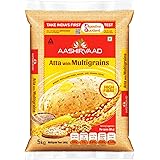Kuttu flour for your Navratri Upvas

Related Reading:
With a variety of nutrients that it offers, the use of kuttu or buckwheat for your recipes can help you in multiple ways. Here are a few benefits that you’ll be rewarded with after adding kuttu/buckwheat to your diet:
- Help in managing blood glucose levels.
- Boost in weight loss.
- Support in healthy digestion.
- Improvement in cardiovascular health.
Though its benefits might make it seem like a great alternative that can not only be used for fasting but also for general purposes, however, it is also vital for you to know the side-effects of unregulated buckwheat consumption before you go any further with your choice.
One of the most common side-effects associated with its consumption is an allergy. It is advised that you check with a doctor if you are allergic to any other seed or grain.
How To Make Buckwheat Flour At Home?
Ready-made buckwheat flour is not always easy to find. It is also not very difficult to prepare buckwheat flour at home. Not only is it convenient, making buckwheat flour at home from scratch can make ensure complete hygiene and quality assurance. Homemade buckwheat flour is free of adulterants (which may be present in the packaged product), and it has a certain homely essence that cannot be replicated by any other.
If you are wondering about the method of preparing it, then you’ll be relieved to know that there isn’t much work involved. All you have to do is get some buckwheat seeds and then pour a single cup into a grinder. After 5-6 minutes of continuous grinding, the mix will obtain the flour-like consistency that you want.
The best thing about buckwheat is that it has an incredible shelf life. Buckwheat seeds can be stored in an airtight container for a whole year, whereas in the case of buckwheat flour, you can store it in a refrigerator for 3-4 months.
Related Reading:
Read our detailed cooking guide on gluten-free flour.
The Reason Behind Avoiding Food In Navaratri
Avoiding grains while fasting during Navaratri is a common practice that has been going on for centuries, but have you ever wondered why? Well, the reason behind the incorporation of this ritual can be summarised with the help of both religious thoughts and Ayurvedic studies.
The principle behind fasting is largely based on a belief that such practice shows your devotion and leads to spiritual purification. Fasting is an excellent way of practicing self-discipline along with other virtues of a similar nature and is believed to be a way of getting closer to the almighty.
And as for its scientific reasoning, you might have noticed that Navaratri usually falls during the time of a seasonal change, which happens twice every year. According to Ayurveda, during this time of the year, our body’s immunity weakens, thus avoiding food items such as grains, meat, onion, or garlic reduces the risk of contracting any disease.
Kuttu Recipes For Navaratri
Buckwheat flour is the most common choice around Indian households when it comes to making food during the 9 day’s fast of Navratri. Let’s take a look at some of the recipes that’ll make sure that you never miss those flavorful days before the Navaratri:
1. Kuttu Ke Pakode (Falhari Pakoda)
Making these fries delicacies would surely be a great treat for you and your family. Made from buckwheat flour and mixed with ingredients such as green peas, coriander, and green chili, these Falhari pakodas will make sure that you get a tasteful experience along with your daily dosage of nutrients.
However, as it is a fried delicacy, make sure that you consume them in a regulated fashion, for too much of it would make you consume a high quantity of unhealthy fats.
2. Buckwheat Kebabs
These could be considered as a great flavorful choice for your fasting days. Made using buckwheat flour and seasoned with green chili, ginger, and cardamom, the only other thing you require to turn it into a perfect meal is a cup of hot tea. This quick would surely turn your fasting into a lovable and flavorful experience.
3. Kuttu Ke Parathe
These are by far the most commonly prepared delicacy and can be enjoyed anytime during the day. Not only is it eaten extensively during the 9-day festival of Navaratri, but it is also a popular recipe prepared on any other ordinary day. The process for their preparation is very similar to that of any other conventional flour, except the buckwheat flour is used as the replacement for wheat, and there is no added common salt in the mix.
4. Kuttu Puris
Yet another fried delicacy, these are made by first preparing dough of buckwheat flour, and then rolling them out in small chapatti-like shape and deep-frying them in a fry-pan. These puris are immensely enjoyed during fasting and can also be eaten during any other time of the year.
5. Kuttu Ka Dosa
Another quick recipe that’ll make you fall in love with fasting. The batter used in order to make this dosa is prepared with the use of buckwheat flour, and if you dislike deep fried stuff but love just little amount of oil for preparation, then this might just be the recipe for you, for it is a quick and easy recipe that uses just a spoonful of oil in order to make a crispy dosa that has the nutty buckwheat taste in every bite. It tastes well alongside chutneys.
Related Reading:
Shopping for Navratri? This Navratri food shopping list is for you.
Frequently Asked Questions
Now you know what kuttu or buckwheat is, so let’s discuss a few interesting FAQs about its nutritional value and how it’s made.
1. What is the actual meaning of kuttu?
Buckwheat is commonly known as kuttu. It is extracted from a fruit seed named Fagopyrum Esculentum plant.
2. What are the main nutritional values of kuttu?
Kuttu is highly nutritious and is loaded with vitamins and minerals. One cup of cooked kuttu contains about 155 calories. They are rich in fibers. Besides these, buckwheat is packed with zinc, folate, magnesium, manganese, Vitamin B6 and phosphorus.
3. Is buckwheat the same as kuttu?
Buckwheat is known as kuttu in Hindi. It is similar to cereals (also known as pseudo-cereal) and is gluten-free in nature.
4. What is kuttu made of?
Kuttu is extracted from a fruit seed, which is why Kuttu flour consumption is allowed during Navratri fasting.
Final Words
While preparing a dish that includes buckwheat flour, also known as kuttu food or kuttu grain, make sure that you are very well aware of its beneficial nature as well as the side-effects that it can cause. Other alternatives for kuttu include well-known names such as chestnut (singhara), quinoa, amaranth, and samai. So it is clear that though Navaratri comes with a lot of restrictions, there is still a long list of ingredients that’ll help you have a great and delicious Navaratri experience.






